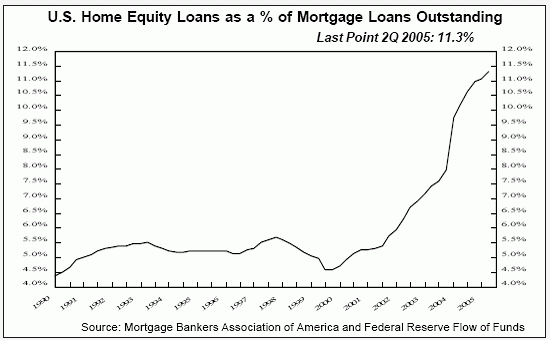|
 |
|||
From the Editor - March 06 |
|||||
|
The commentary below is from our monthly newsletter and is provided here as a convenient reference for our readers. |
|||||
|
Interest Rates and the Economy It is all but a given right now that the Federal Reserve Board will raise short-term interest rates at least once more from 4.5% to 4.75%, with an increasing number of economists predicting a final rate increase to 5% this summer. A small but growing number are even forecasting a Fed funds rate as high as 5.25%. That’s great news for earning interest in your savings account (see below on how best to do this), but not so great in general. Historically, the Feds have always raised (or lowered) rates more than necessary to achieve their targeted goals. At least that’s what all the “armchair quarterbacks” say. Before Alan Greenspan left the Federal Reserve Board, he indicated in one of his clearer-than-usual speeches that the Fed’s goal in raising rates was to target, not so much inflation in general, but “inflation” in housing prices. One of the unintended consequences of a loose money supply in the earlier part of this decade was that mortgages became quite affordable for the average person. That led to a) more people buying houses for the first time, b) more people buying bigger houses (meaning, more expensive) than they might otherwise have ever considered, and c) home prices overall rising at an accelerated pace—and in certain parts of the country at meteoric rates! Obviously, as interest rates have headed up, mortgage rates have risen in tandem. There is already clear evidence that at least the rate of increase in housing prices is slowing. The Fed is starting to achieve a major goal of theirs in pricking the balloon in housing prices with a needle, hoping to let some air out without having the balloon pop. A collapse in the housing market would be detrimental to the economy. We believe such a collapse, or even a drop in housing prices, is unlikely to happen (unless you live in, say, Boston). While the naysayers talk about how bad mortgage rates at 6.5-7% would be, many of our readers can remember when, not so very long ago, a 6.5% 30-year fixed rate mortgage was a great rate! The problem this time around is that houses are more expensive, and housing prices have increased over the past several years at a faster rate than incomes. This simply means that many future buyers will have to set their sights on smaller houses (that will still be 50% larger—at least—than the average-size house in the 1950s). The proliferation of “McMansions” will cease, with no one mourning their demise (except you, if you were planning to build one). Modular and “pre-fab” homes will become more socially acceptable in many communities. In other words, people will still find affordable ways to purchase houses. The sizes just might have to be a tad smaller…until incomes rise to support the purchase of larger homes, or until we begin the cycle of Fed-induced lower interest rates all over again. The Real Problem with Higher Rates If housing prices are unlikely to fall as rates rise to a new, higher, equilibrium range, what then is the real problem with increasing rates? It is this. Homeowners have been “spending” their homes like never before. See the graph below, which shows that over the past five years homeowners collectively have doubled the amount of money “extracted” from their homes. As housing prices have risen, it has become more and more tempting to borrow money for other purposes via a home equity loan. And when home equity loans were in the 4-5% interest rate range, who wouldn’t be tempted? The problem is, now all these borrowers have to pay back the loans at rates in the 7-8% range, and soon perhaps in the 8-9% range. Ouch. Rising home equity loan rates means two things. First, all those people who have taken out loans in unprecedented numbers will have to take cash they might otherwise have used to buy things and use instead for loan repayment. Second, the temptation to borrow against your house is quickly diminishing, drying up a major source of stimulus for the economy. In both cases, this suggests that consumer spending will slow. That means slower growth for the economy. It could mean a recession, but no one knows for sure (yet).
What does all this mean for the stock market? In a word, “choppy.” It’s likely that the market will have to climb the proverbial “wall of worry” through at least this summer until it becomes clear that the Feds have ceased raising interest rates. Once the market becomes confident of this, it will likely respond favorably. If you have new cash to invest, you might consider waiting a bit until there is a market pullback. Having a little extra cash on the sidelines is not at all a bad idea. Of course, the real challenge for you, as with everyone, is to actually pull the trigger and invest that extra cash when (if) the stock market really does dip somewhat over the next several months. The most painful time to invest is also almost always the more financially rewarding time. If interest rates are on the rise, at least you should try to make the most of it. Try to put as much of your spare cash as possible in a high yielding money market. Right now, PayPal has about the highest rate you can find anywhere at 4.5%. The only minor drawback is that PayPal makes you jump through a couple extra security hoops to get set up, but once you’ve got your account, it’s extremely easy to transfer money back and forth from your PayPal account to your checking or savings account. And besides, everyone should have a PayPal account so you can make purchases on eBay! Our one major complaint with PayPal is that it takes 3-4 business days to actually transfer funds to or from your bank account to your PayPal account. They won’t admit it, but that’s just PayPal’s attempt to make a little extra money off the “float” while the funds are in transition (they’re not really in transition, they’re just sitting in a PayPal corporate account earning interest that you don’t get). But for the current interest rate they are paying, that’s an easy offence to overlook. This summer may prove to be a great time to lock in some longer term CDs, if you want or need to secure some attractive rates at guaranteed returns for the next two to five years. CD rates are beginning to be attractive now, but we expect the best deals to be found this summer, just after the Feds finish their cycle of interest rate hikes. Please visit our blog for a more detailed discussion of our Model Stock Portfolio changes.
|
|||||
